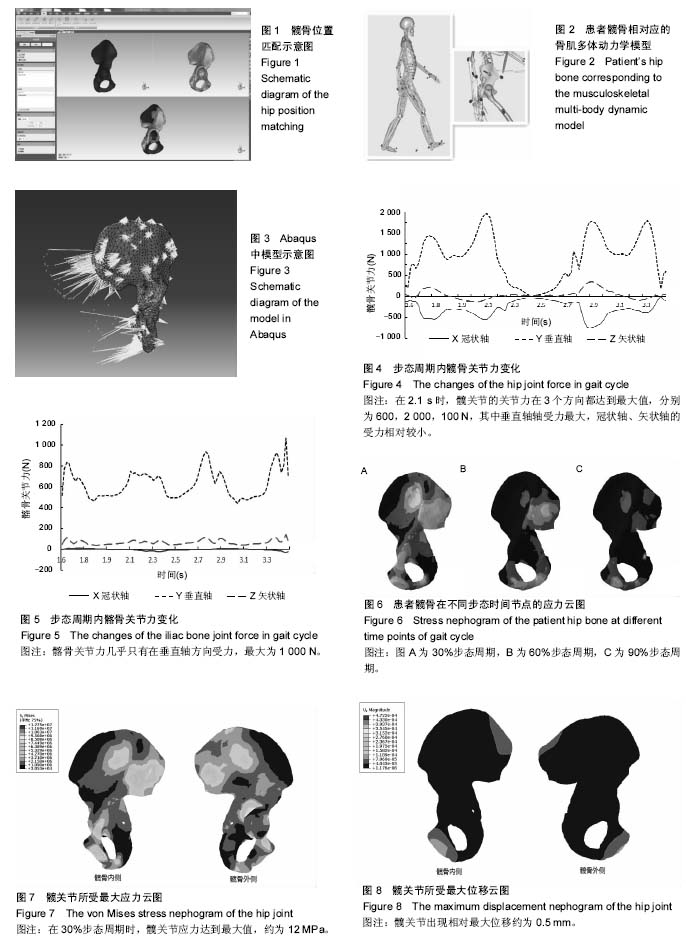| [1] 李春蓉,杨莲欢.优质护理对髋骨骨折患者术后并发症发生率及满意度的影响[J]. 中国当代医药,2016,23(11):193-194.[2] 曾丽. 优质护理对髋骨骨折患者术后并发症发生率及满意度的影响[J]. 中国医药导刊, 2015,17(9):955-956.[3] 何学安, 罗兵. 数字骨科在骨科临床的研究进展[J]. 中国社区医师, 2016,32(6):19.[4] 章莹,尹庆水,万磊,等. 数字技术在创伤骨科的应用 临床数字骨科(一)[J]. 中国骨科临床与基础研究杂志, 2011, 3(2):113-119.[5] 李国庆.髋臼骨折内固定数字化模型的构建及有限元分析[D]. 华中科技大学,2013.[6] Phillips AT,Pankaj P,Howie CR,et al. Finite element modelling of the pelvis: inclusion of muscular and ligamentous boundary conditions. Med Eng Phys. 2007;29(7):739-748.[7] 黄进成,刘曦明,蔡贤华,等.复杂髋臼骨折内固定术后有限元分析[J]. 中华实验外科杂志,2014,31(7):1454-1456.[8] 张景僚. 骨盆三维有限元模型的建立及其分析[D]. 第一军医大学, 2007.[9] 魏帅帅. 髋臼骨折术后个体化有限元分析[D]. 华中科技大学, 2012.[10] 邱长茂. 髋臼骨折术后股骨头内移对臼顶负重区应力影响的有限元分析[D]. 天津医科大学, 2015.[11] Chu A, Hughes RE. A method to determine whether a musculoskeletal model can resist arbitrary external loadings within a prescribed range. Comput Methods Biomech Biomed Engin. 2010;13(6):795-802.[12] 刘书朋,司文,严壮志,等.基于AnyBody TM 技术的人体运动建模方法[J]. 生物医学工程学进展,2010,31(3):131-134.[13] 杨挺,郑建河,姚子龙,等.行走中股骨生物力学特性的有限元分析[J].广东医学,2016,37(4):512-515.[14] 吕国敏.基于AnyBody的汽车驾驶员坐姿力学特性建模及坐姿支撑设计[D].山东大学,2016.[15] 华猛.基于AnyBody生物力学仿真的驾驶姿势舒适机理研究[D].吉林大学,2015.[16] 刘述芝,胡志刚,张健.冲击载荷作用下运动员下肢动态响应的逆向动力学仿真[J].医用生物力学,2015,30(1):30-37.[17] 陈瑱贤,王玲,李涤尘,等.全膝关节置换个体化患者右转步态的骨肌多体动力学仿真[J]. 医用生物力学,2015,30(5):397-403. [18] 单丽君,胡忠安.基于AnyBody的髋关节康复训练肌肉力的分析[J].大连交通大学学报,2014,35(1):50-52.[19] Damsgaard M, Rasmussen J, Christensen ST, et al. Analysis of musculoskeletal systems in the AnyBody Modeling System. Simulat Modell Pract Theor. 2006;14(8):1100-1111.[20] 丁光兴.基于个性化的长管骨有限元参数化建模及实验验证[D].南京理工大学,2012.[21] 魏峰.基于CT图像的人体腰椎有限元模型构建与力学分析[D].南京理工大学,2015.[22] Janko DJ, Miomir LJ. Finite element modeling of the vertebra with geometry and material properties retrieved form CT-scan data. Mech Eng. 2010;8(1):19-26.[23] GB 10000-1988 中国成年人人体尺寸[S].[24] 张迪.基于运动捕捉数据的三维人体运动合成[D].长安大学, 2015.[25] 赵明光.人工全髋关节置换三维有限元建模及其在体生物力学研究[D].河南科技大学,2013.[26] 聂涌,马俊,康鹏德,等.正常步态周期中髋臼周围区域的应力分布及其在THA髋臼重建中的指导[J].医用生物力学, 2014,29(1): 31-37. [27] 荀福兴. 不同材料属性分配方法对椎体有限元模型力学性能的影响[D]. 南方医科大学, 2013.[28] 张国栋,廖维靖,陶圣祥,等. 股骨有限元分析赋材料属性的方法[J]. 中国组织工程研究,2009,13(43):8436-8441.[29] 张国栋,廖维靖,陶圣祥,等. 股骨颈有限元分析的赋材料属性方法探讨及有效性验证[J]. 中国组织工程研究, 2009, 13(52): 10263-10268.[30] Hao Z, Wan C, Gao X, et al. The effect of boundary condition on the biomechanics of a human pelvic joint under an axial compressive load: a three-dimensional finite element model. J Biomech Eng. 2011;133(10):101006.[31] 刘欣伟,闫寒,刘中洋,等. 包含肌肉、韧带组织的骨盆、髋臼3D有限元模型的构建[J]. 临床军医杂志,2014,42(4):331-335.[32] Kaku N, Tsumura H, Taira H, et al. Biomechanical study of load transfer of the pubic ramus due to pelvic inclination after hip joint surgery using a three-dimensional finite element model. J Orthop Sci. 2004;9(3):264-269.[33] Li J, Stewart TD, Jin Z, et al. The influence of size, clearance, cartilage properties, thickness and hemiarthroplasty on the contact mechanics of the hip joint with biphasic layers. J Biomech. 2013;46(10):1641-1647.[34] Coultrup OJ, Hunt C, Wroblewski BM, et al. Computational assessment of the effect of polyethylene wear rate, mantle thickness, and porosity on the mechanical failure of the acetabular cement mantle. J Orthop Res. 2010;28(5): 565-570.[35] Shi D , Wang F , Wang D , et al. 3-D ?nite element analysis of the in-?uence of synovial condition in sacroiliac joint on the load transmission in human pelvic system. Med Eng Phys. 2014;36:745-753 .[36] Cilingir AC, Ucar V, Kazan R. Three-dimensional anatomic finite element modelling of hemi-arthroplasty of human hip joint three-dimensional anatomic finite element modelling of hemi-arthroplasty of human hip joint. Trends Biomat Artific Organs. 2007;21(1):79550B-79550B-8.[37] Kainz H, Modenese L, Lloyd DG, et al. Joint kinematic calculation based on clinical direct kinematic versus inverse kinematic gait models. J Biomech. 2016;49(9):1658-1669. |
.jpg)

.jpg)
.jpg)